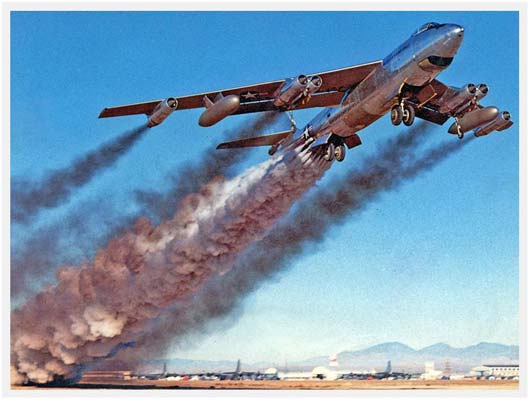CoolPix - Modern Military: Holy Smoke! B-47 Stratojet JATO Takeoff
 Sunday, March 7, 2010 at 10:27PM
Sunday, March 7, 2010 at 10:27PM This amazing entry in the CoolPix collection helps to set the line between ‘Vintage Military’ and ‘Modern Military’. I’ve decided we’ll make the break at the end of WWII. This also fits pretty well since that’s basically the time period where we entered the jet age as well.
This pic is from 1954 of a Boeing B-47 making a Jet Assisted Take Off (JATO). The rather massive JATO package was a great help in getting the aircraft off the ground a lot quicker than with just the 6 wing mounted jet engines. Tho the airplane was fast, with a cruising speed of about 550mph, the jet engine technology of the time didn’t make good thrust at slow speeds. JATO was a good solution to this issue at the time. It’s really interesting to see this huge amount of smoke pouring out of the rockets, as well as a lot coming the 6 jets too. Early jet engines were also well known for making a lot of smoke!
It’s also very cool to see 3(!) B-36’s in the background. This is truly a fascinating picture. The original picture on the internet has several cracks in the photo paper and other blemishes. I’ve photoshopped those out and made a near perfect pic here for you to enjoy : )
Seems like the Boeing B-47 Stratojet is often forgotten in history, at least compared to how much of a quantum leap the airplane was. First flight took place in December 1947, a little over 2 years after the end of World War 2. The distance in design philosophy from an airplane like the B-29 to the B-47 is pretty staggering. The key elements being the swept wing and the jet engines. The other aircraft in the running for the US Military contract for a long range jet bomber were all configured with a straight wing. The B-47 concept also began with a straight wing, but as development continued, Boeing engineers turned to German information gained after the war on swept wing technology. Boeing committed to the swept wing (35 degrees on the B-47), and at that point, one of the most important elements to usher in a successful jet age, both military and civilian, was defined.
Here are a few other interesting pieces of info on the B-47:
It was thought that the wing would have to be thin to achieve high speeds, thus the fuel was carried in the fuselage, or in underwing external tanks. Fuel location had to be managed carefully to keep the center of gravity in the proper position.
The design was so aerodynamically clean, and early jet engines were so slow to spool up, that a drogue chute was utilized in flight during the landing phase to create drag. This allowed the engines to carry some power in the event of a missed approach while also allowing a steeper approach angle without excessive speed.
The airplane had a high wing loading which resulted in a pretty high approach and touchdown speed. A second, larger parachute was installed to deploy after touchdown to help slow the airplane. Thrust reversers hadn’t been invented yet.
 Martt |
Martt |  12 Comments |
12 Comments | 














































































Reader Comments (12)
A small correction. The J-47 engine used on the B-47 was not a particularly smoky engine in normal use. During the takeoff roll, engine performance was enhanced by water-alcohol injection into the burner cans, thus increasing thrust for a shorter takeoff roll. This depiction shows the aircraft immediately after takeoff. ATO bottles are still putting out, and water-alcohol will remain for several more seconds. There could be as many as 33 ATO bottles on the ATO Rack slung under the fuselage just behind the rear bicycle landing gear. ATO was calculated to be fired 3 seconds before takeoff and duration would last until 4 seconds after takeoff. The rack was then jettisoned with the attached bottles in a jettison area.
When I was at school in 1957 ,my classroom was underneath the approach to RAF Chelveston in UK.We always wondered why the B47s had the drogue chutes on approach ,now I know.Great plane and still looks good.
TW
martfenn e3d3fd1842 https://social.disanmientrung.vn/dingdenmattlic
martfenn e3d3fd1842 https://social.disanmientrung.vn/dingdenmattlic
martfenn e3d3fd1842 https://social.disanmientrung.vn/dingdenmattlic
martfenn e3d3fd1842 https://social.disanmientrung.vn/dingdenmattlic
martfenn e3d3fd1842 https://social.disanmientrung.vn/dingdenmattlic
jarritrem e3d3fd1842 https://www.frenchwomenorg.com/smargeobullca
jarritrem e3d3fd1842 https://www.frenchwomenorg.com/smargeobullca
jarritrem e3d3fd1842 https://www.frenchwomenorg.com/smargeobullca
jarritrem e3d3fd1842 https://www.frenchwomenorg.com/smargeobullca
The B-47 was unsafe at ANY speed.. Over 200 crashed while being flown by the best pilots on the planet at that time.. Imagine today, after the 3rd crash ALL of them would have been grounded, probably forever, but the Russians were coming and lives were cheap.. Look up the details on this junk and it'll surprise you.. Boeing, Boeing.. LOL..LOL.. They should have went back to the drawing board.. I think the F-104 was bad as well, but at least it only took just the pilot.. The B-47 would put the pilot in situations that he could NOT recover from, no matter what.. They caught fire, broke apart, crashed on landing and takeoff, blew up in flight, on and on and on.. You can find the cause of each crash online, and the Air Force named PILOT ERROR in a lot of them because they didn't want to be blamed for accepting a piece of garbage.. Many a widow had to sit there and take it that their husband did something wrong when it was just a bad, bad, design..